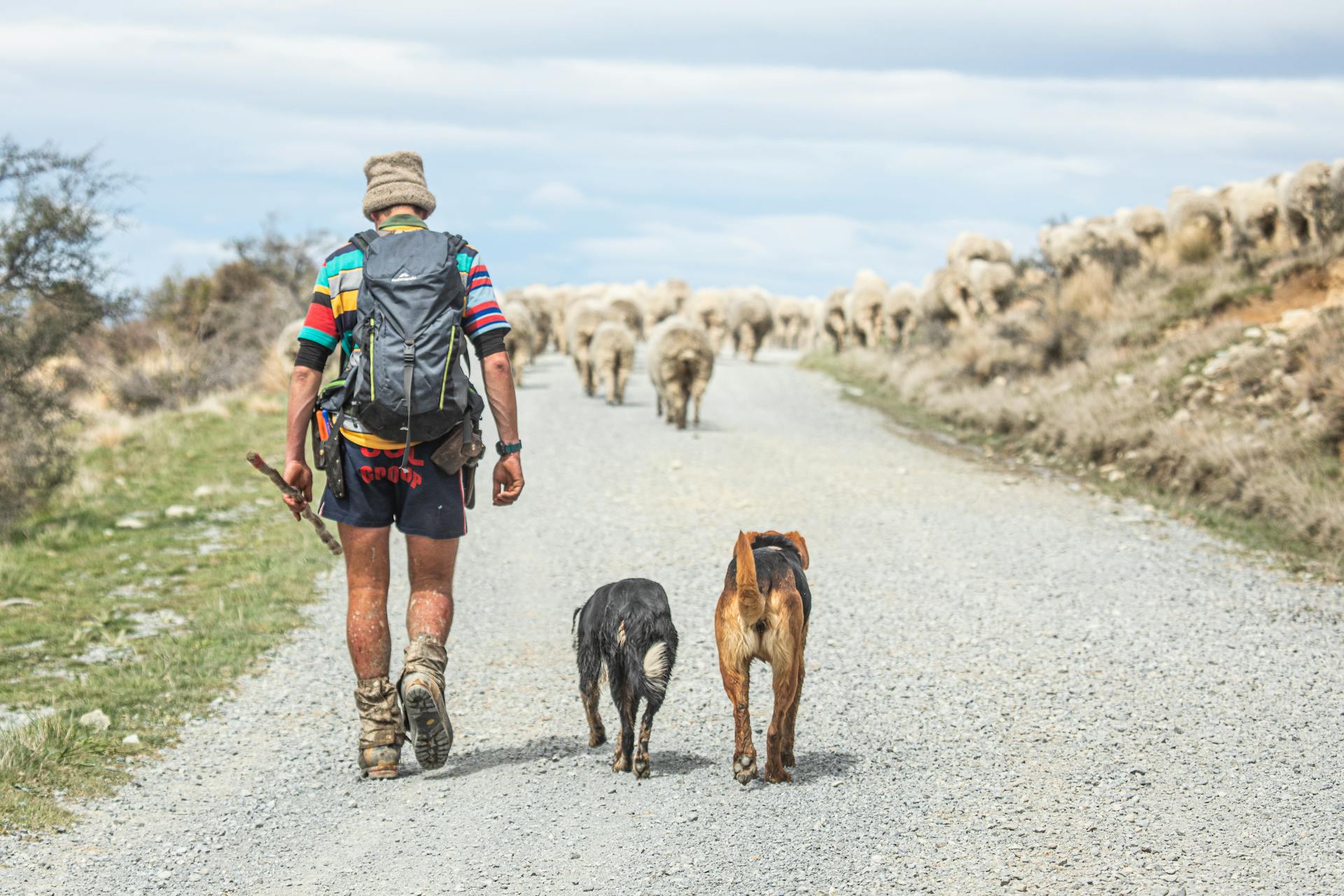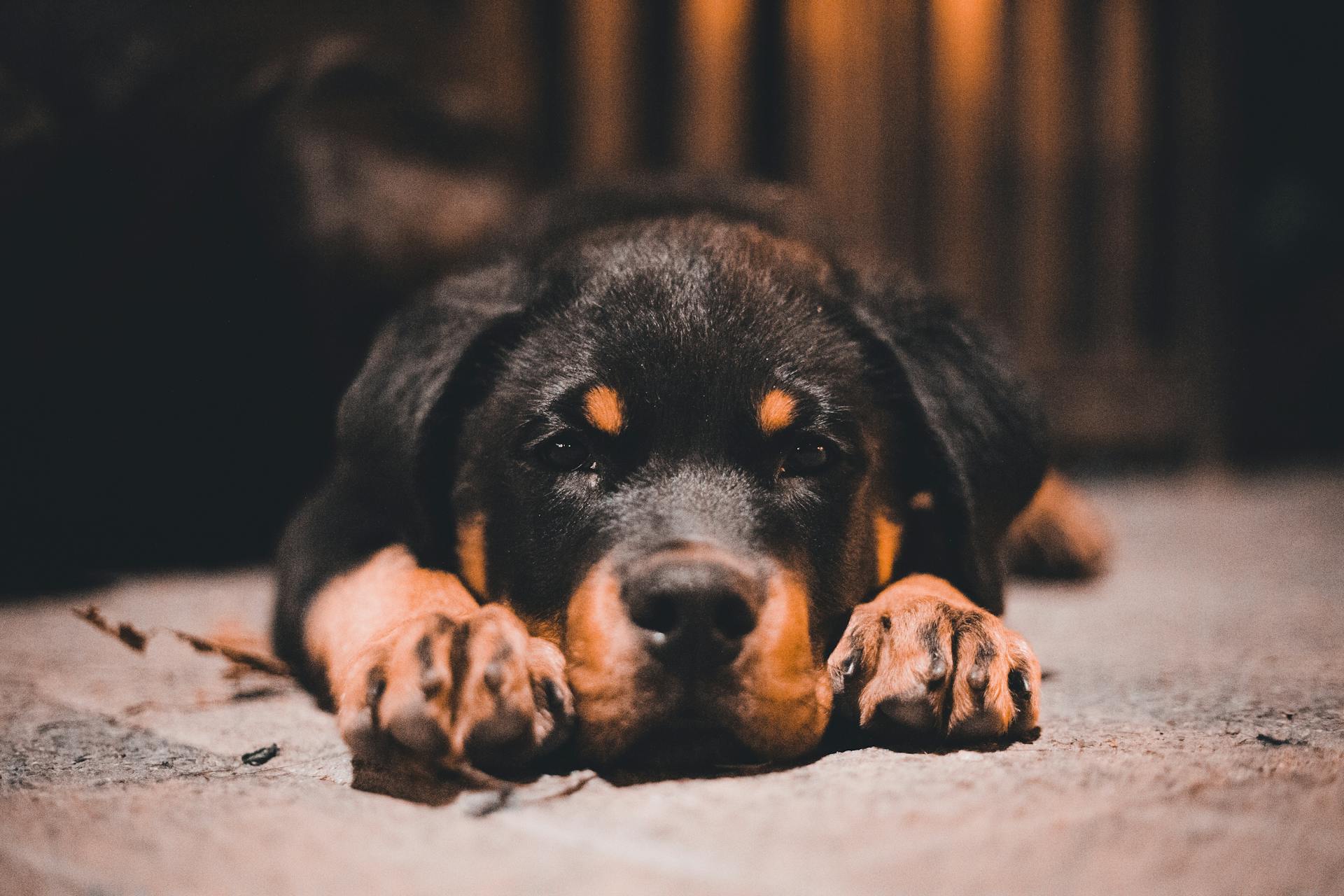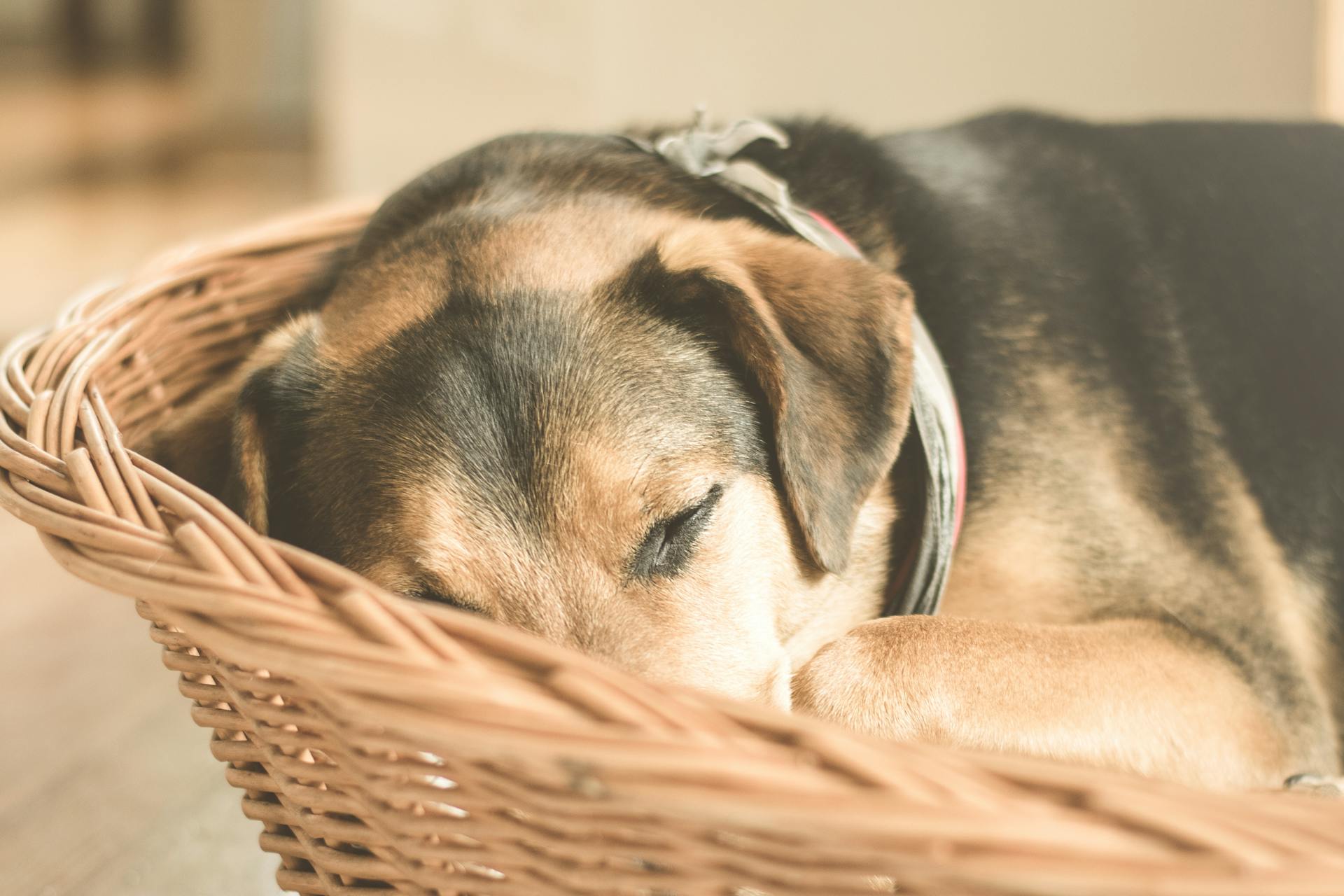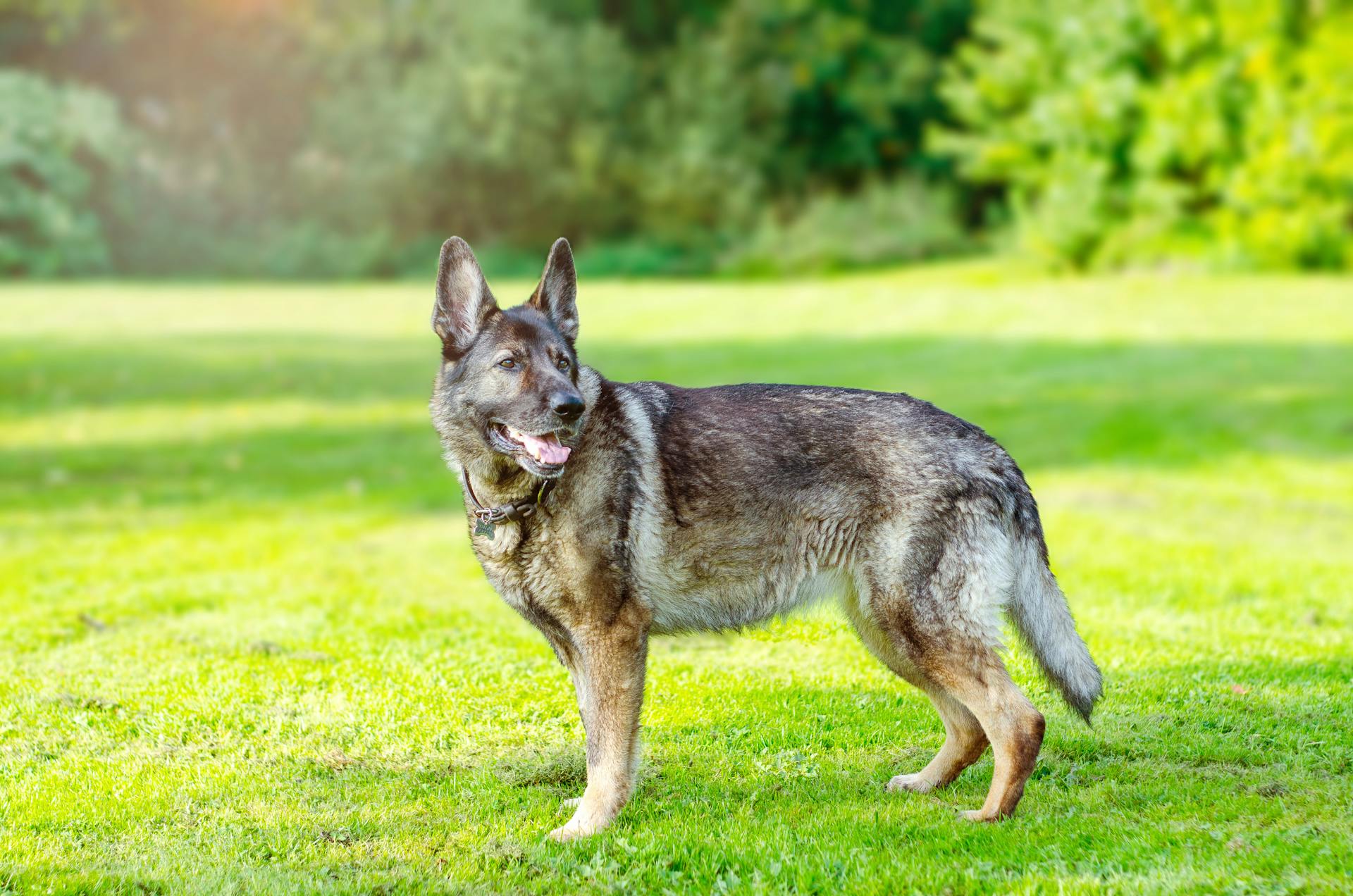
German Shepherds are one of the most popular breeds in the world, and for good reason - they're intelligent, loyal, and loving companions. They were originally bred to herd sheep, hence the name, but today they're often used as police and military dogs due to their keen instincts and athleticism.
German Shepherds are a medium to large breed, with males weighing between 75-95 pounds and standing between 24-26 inches tall at the shoulder. This size means they need plenty of exercise and mental stimulation to stay happy and healthy.
One thing to consider when owning a German Shepherd is their high energy level - they need at least an hour of exercise per day to keep them physically and mentally fit. This can be a challenge for busy owners, but with some planning and creativity, it's definitely doable.
For your interest: Do Border Collies Need to Be Groomed
Exercise and Health
German Shepherds are an active breed that needs long play sessions or walking every day to avoid boredom, depression, and behavioral problems.
Regular exercise can help prevent health issues such as hip and elbow dysplasia, which can cause pain and arthritis in later life. A study found that 19.1% of German Shepherds are affected by hip dysplasia.
Exercise also helps maintain a healthy weight, which is crucial for overall health. The American Veterinary Medical Association estimates that extra weight can decrease your pet's overall life expectancy by more than two years.
To ensure your German Shepherd gets enough exercise, consider the following activities:
- Agility trials
- Dock diving
- Nose-work such as tracking
These activities will not only provide physical exercise but also mental stimulation, which is essential for a happy and healthy German Shepherd.
Exercise Needs
Exercise is essential for your German Shepherd's physical and mental well-being. They need daily long play sessions or walks to avoid boredom, depression, and behavioral problems.
A long-haired German Shepherd, in particular, requires hours of physical and mental stimulation daily. This can be in the form of playtime, training, or simply spending quality time with your dog.
If you don't have time to provide this level of exercise, it's not fair to the dog. Failing to meet their needs can lead to behavioral issues, with boredom being a common reason for bad behavior.
Here's a breakdown of the exercise needs of a long-haired German Shepherd:
This breed thrives when they have a job to do, so if you're not planning to work with your German Shepherd, you'll need to provide plenty of physical and mental stimulation. This can include activities like agility trials, dock diving, and nose-work such as tracking.
Ensuring Good Health
German Shepherds are prone to certain health issues, such as hip and elbow dysplasia, which can cause pain and arthritis later in life. A study by the Orthopedic Foundation for Animals found that 19.1% of German Shepherds are affected by hip dysplasia.
Regular exercise can help prevent some of these issues, but it's also essential to provide a well-rounded diet. A good diet can help prevent conditions like heart disease and diabetes. Try to stick to a consistent feeding schedule, prioritizing high-nutrient foods that are low in carbohydrates and sugars.
Recommended read: German Shorthaired Pointer Diet
Aim to feed your German Shepherd three smaller meals per day, rather than a single chow session. This can help keep your pup energized and sustained throughout the day. Regular vet visits are crucial to your pet's ongoing health and longevity.
German Shepherds are also at risk of bloat, a life-threatening condition that can kill dogs within hours if left untreated. To reduce the risk of bloat, avoid foods that use soybean meal or have oils or fats within the first four ingredients on the label. Split your dog's food into at least two meals per day, and invest in a slow feed bowl to prevent eating quickly.
Here are some common health issues to watch out for in German Shepherds:
- Hip and elbow dysplasia
- Degenerative myelopathy
- Exocrine pancreatic insufficiency
- Bloat (gastric dilatation-volvulus)
- Epilepsy
- Heart disease
- Diabetes
Regular grooming is also essential to prevent matting and tangling of their long hair. Brush your German Shepherd's coat at least a few times a week to keep it tangle-free. After outdoor activities, check their belly for debris like dirt and leaves.
When to Stop Growing?
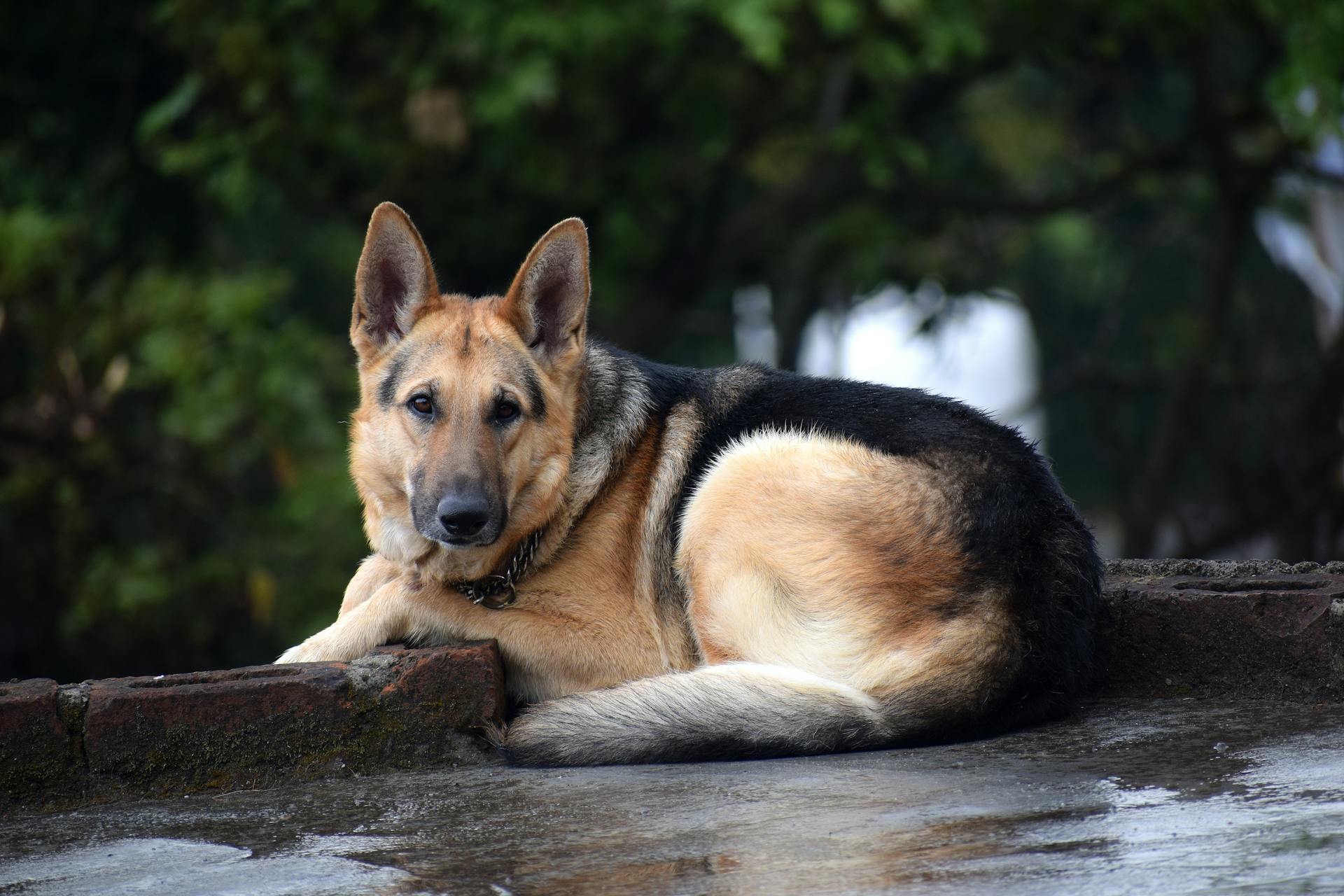
A German Shepherd is not considered fully grown until they are about 18 months old.
Males take longer to fill out, requiring more time to develop their chest and abdomen, and can continue to grow until they are two and a half years old.
Female German Shepherds typically fill out by two years old, but can continue to grow until they are three years old.
If your GSD is older than 36 months and continues to put on weight, it's essential to consult with your veterinarian to ensure weight gain doesn't lead to obesity.
Readers also liked: Bull Terrier 100 Years Ago
Grooming and Care
Grooming a long-haired German Shepherd requires regular attention to keep their coat tangle-free, with brushing at least a few times a week.
Their long fur is prone to tangling and matting, and the undercarriage can catch debris while outdoors, so checking their belly after outdoor activities is a must.
You'll also need to brush their teeth daily and trim their nails occasionally, just like with any other dog.
Brushing their coat frequently will not only keep it knot-free but also reduce the amount of fur all over your home from shedding.
Suggestion: German Shorthaired Pointer Free to Good Home
Grooming Needs
The German Shepherd sheds continuously and requires daily grooming.
Their long-haired coat needs attention almost daily to keep it tangle-free.
You'll need to brush their coat at least a few times a week to prevent matting and tangling.
After outdoor activities, be sure to check their belly for debris like dirt and leaves.
Long-haired German Shepherds shed a lot all year round, with even more shedding in the fall and spring.
You'll need to brush them frequently to reduce the amount of fur all over your home from shedding.
Occasional baths, nail trims, and daily teeth brushing are also essential for their grooming needs.
Consider reading: How Much Exercise Do Border Collies Need
Routine Vet Care
Routine vet care is essential for your furry friend's health and well-being. You should schedule an annual visit to ensure they're fit and healthy, which can range from $50–$100.
Dental disease is a very common issue that can lead to more serious health problems if left untreated.
Yearly wellness checkups can help catch any potential issues early on.
You may also need to spend additional money on treatments like antibiotics or tests, including ultrasounds and x-rays, if the need arises.
Here are some additional costs you might incur for your dog's care:
Temperament and Personality
German Shepherds are known for being loyal and loving to their families, making them great companions.
They are highly intelligent and obedient, which makes them easy to train with positive reinforcement. German Shepherds thrive when given a job to do and will enjoy being rewarded when they obey cues.
With proper socialization, they can quickly acclimate to new people and become friendly. However, if not socialized correctly, they can become overprotective of their family and territory.
These dogs are naturally wary of strangers, but with early socialization, they can learn to be friendly towards new people. They are also great with kids and can live with other animals if socialized during puppyhood.
German Shepherds are brave and alert, making them great watchdogs. They are willing to jump to their owner's defense in threatening situations, but this can become aggression if not trained properly.
With the right training and socialization, German Shepherds can become well-behaved and loving companions. They are not aggressive by nature, but rather protective of their family and territory.
Recommended read: Water Loving Dogs for Short Nyt
Their high energy levels can sometimes get destructive if not given constructive ways to burn off that energy, but with proper exercise and training, they can become calm and relaxed.
Overall, German Shepherds are a great breed for families who are willing to put in the time and effort to train and socialize them properly.
Recommended read: Are Border Collies High Energy
Compatibility and Interaction
German Shepherds are natural herders, which means they have a strong instinct to protect and care for their family. They can live with other animals, including dogs, cats, and small mammals, if socialized properly from an early age.
Socialization is key to a smooth household with a German Shepherd. They can be territorial, so it's essential to introduce new pets slowly and under controlled circumstances. This will help prevent any potential conflicts.
With proper socialization and supervision, German Shepherds can form life-long bonds with their family members, including children. They have enough energy to keep up with kids and enjoy playing with them, but it's crucial to teach children how to interact safely with dogs.
Interacting with Other Animals
German Shepherds can live with other animals, including dogs, cats, and small mammals like rabbits and guinea pigs, with proper socialization.
They're naturally inclined to corral and protect other animals, which is why early socialization is vital to ensure a harmonious household.
German Shepherds can be territorial and may see another pet as invasive, which can cause problems.
They may even chase squirrels in the yard, and if they catch them, they might kill them.
However, with patience and proper introduction, German Shepherds can form life-long bonds with other pets.
It's essential to supervise interactions between children and dogs to avoid unnecessary irritation or stress.
Children should be taught how to pet and play with any dog gently, and parents should ensure their child is interacting safely with the dog.
With socialization, long-haired German Shepherds can live with other animals and even enjoy playing with them, but it's crucial to supervise playtime to prevent accidents.
Choosing the Right Pet
Choosing the right pet is a big decision, and it's essential to consider their needs and your lifestyle. You should not get a dog that doesn't fit into your lifestyle, as it can be unfair to the dog.
If you're considering getting a long-haired German Shepherd, you'll want to think about their need for physical and mental stimulation. Failing to meet their needs can lead to behavioral issues, like boredom, which can cause them to act out.
You'll want to ask yourself if you have time to provide hours of exercise and mental stimulation daily. If the answer is no, you may want to consider a different breed.
A long-haired German Shepherd is right for you if you're looking for a dog that's active, a good watchdog, and affectionate. They're also great for agility trials and other canine sports, and they're easy to train.
Here are some key qualities to consider:
- Active dog: long-haired German Shepherds need regular exercise and physical activity.
- Good watchdog: they're naturally protective of their family and territory.
- Affectionate: they love people and enjoy spending time with their owners.
- Easy to train: they're highly intelligent and responsive to commands.
Ultimately, choosing the right pet means considering their needs and your lifestyle. With the right match, you can build a happy and fulfilling relationship with your furry friend.
Origin and History
The German Shepherd breed has a rich history that dates back to the 1800s in Germany. They were first bred by Max von Stephanitz as working dogs to protect farms from predators and assist farmers with herding livestock.
Their intelligence, speed, strength, and keen sense of smell made them perfect for this job, and they were given food and shelter in exchange for their service. However, few were considered pets or family companions at the time.
By the early 1900s, German Shepherds began winning over German families with their courageous and kind temperaments, and they quickly became popular throughout Germany and Europe. Their high intelligence and heightened perceptions also made them ideal as guide dogs for the blind.
Check this out: Giant Schnauzer Germany
Origin
The German Shepherd breed originated in Germany in the late 1800s. The most intelligent, responsive, and obedient local shepherd dogs in Germany were bred to create what is now known as the German Shepherd.
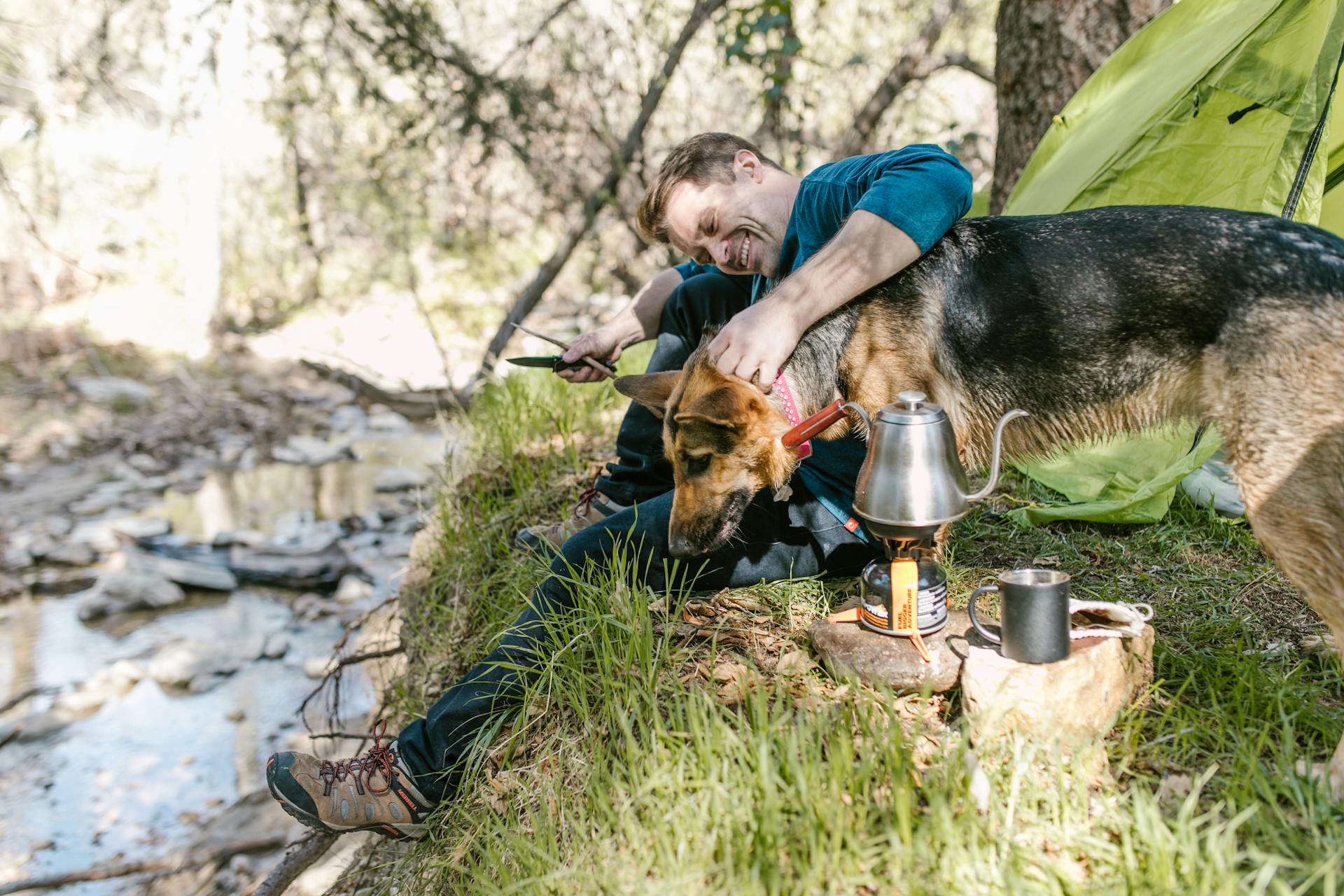
Capt. Max von Stephanitz registered his dog, Horan, as the first German Shepherd in 1899. This marked the beginning of the breed's development as a herding dog.
German Shepherds were bred to have versatility and quickly became popular as guard dogs, police dogs, and sight dogs for the blind. Their superb sense of smell and courageous character made them an ideal police dog.
The breed's reputation for being courageous and easy-to-train made them a popular choice for various roles. They were welcomed as police dogs and sight dogs for the blind due to their loyal and courageous character.
By the beginning of World War I, the German Shepherd was popular throughout Germany and quickly spread to other parts of the world. People loved German Shepherds for their loyal and courageous character.
A fresh viewpoint: German Shepherd Loyal Dogs
Finding a Breeder
Finding a reputable breeder is crucial when searching for a long-haired German Shepherd. They should have a good understanding of the breed and its needs.
A reputable breeder will be happy to share their credentials with you, including how long they've been in business and their experience with long-haired German Shepherds.
You should also ask to see health tests for the parent animals, as this is a sign of a responsible breeder.
A good breeder will also be willing to show you where the dogs are kept, giving you an idea of the living conditions.
Meeting the parents is also a great way to gauge their temperaments and the potential temperaments of the puppies.
Socialization is key for puppies to become friendly and confident, so ask about their socialization process.
Make sure the puppies are up-to-date on vaccinations, and ask about their health history.
A reputable breeder will offer a health guarantee with a contract, protecting both you and the puppy.
Here are some questions to ask a potential breeder:
- What are your credentials?
- Have the parent animals undergone health testing?
- Can I see where the dogs are kept?
- Can I meet the parents?
- How do you socialize your puppies?
- Are the puppies up-to-date on vaccination?
- Do you offer a health guarantee with a contract?
- What do you require of potential adopters?
Appearance and Size
German Shepherds are medium to large-sized dogs, typically weighing between 50 and 90 pounds and standing 22 to 26 inches tall. Females are generally smaller than males.
Their height and weight vary significantly between sexes, with males reaching 24 to 26 inches in height and weighing 75 to 90 pounds, while females reach 22 to 24 inches in height and weigh 55 to 70 pounds.
Here's a chart to give you a better idea of their size:
What Do They Look Like?
German Shepherds are a medium to large-sized breed, with males reaching a height of 60-65 cm (24-26 in) and females reaching 55-60 cm (22-24 in). Their bodies are longer than they are tall, with an ideal proportion of 10 to 8+1⁄2.
The breed standard height at the withers is 60–65 cm (24–26 in) for males, and 55–60 cm (22–24 in) for females. They can reach sprinting speeds of up to 30 miles per hour.
German Shepherds have a double coat which is close and dense with a thick undercoat. The coat is accepted in two variants: medium and long. Most commonly, German Shepherds are either tan/black or red/black.

Here are some common coat types and colors found in German Shepherds:
- Saddle black-and-tan coat
- Black mask and sable
- Solid black
- Bi-colour
- Long-haired black-and-tan
Long-haired German Shepherds look just like classic German Shepherds, but with a long, sleek, and shiny coat. Their ears have extra fluff around them, and their tails are bushier. They tend to have longer hair on the chest that is reminiscent of a ruff or a lion’s mane.
Long-haired German Shepherds are the same size as regular German Shepherds, weighing between 50 and 90 pounds and standing 22 to 26 inches tall.
How Big Will My Get?
Your German Shepherd puppy will grow at an incredible rate, and it's essential to understand how big they'll get. German Shepherd puppies are adorable, but they grow in a blink of an eye.
To gauge how much bigger your German Shepherd will get, check their age. If your GSD is younger than two years old, they definitely have room to keep growing! Another way to tell if your pup still has a lot of growing to do is their paw size. Do their paws look large compared to their legs and body? This is a classic adolescent feature of a dog and means your pup is likely still growing!
Additional reading: Will Shiba Inu Reach 1 Dollar
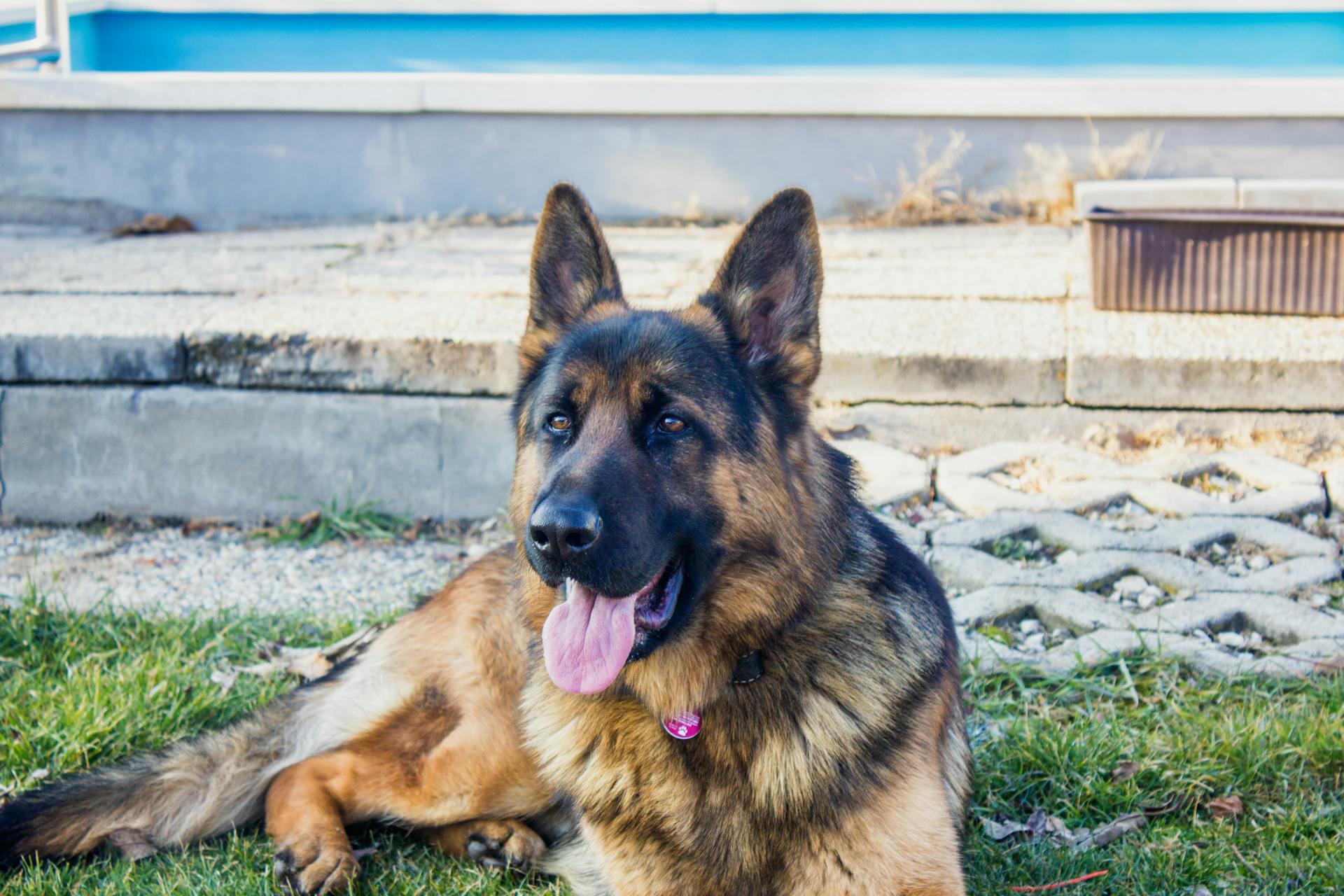
The estimated full-size varies significantly between sexes. In terms of weight, an adult male German Shepherd weighs anywhere from 75 to 90 pounds, while a female German Shepherd weighs 55 to 70 pounds. Your puppy's weight will vary depending on their gender, environment, feeding schedule, and exercise routine.
Here's a rough estimate of your German Shepherd's growth:
Keep in mind that these numbers are only estimates, and your puppy may grow at a different rate. Regular vet appointments will help ensure your pup is healthy and happy.
Frequently Asked Questions
What is the largest German Shepherd type dog?
The King Shepherd is a giant hybrid dog resulting from the cross-breeding of German Shepherds and Shiloh Shepherds, known for its massive size. It's considered one of the largest German Shepherd-type dogs due to its exceptional size.
What large dog is like a German Shepherd?
The King Shepherd is a large dog breed that resembles a German Shepherd, typically standing 25-31 inches tall and weighing up to 150 pounds. This massive breed is a cross between a German Shepherd and another large breed, such as a Malamute or Great Pyrenees.
What is a king size German Shepherd?
A King Shepherd is a large, gentle breed that thrives on human companionship and loves to be around its family at all times. They are often described as "big lovable babies" who enjoy lounging around the house with their owners.
What is the lifespan of an extra large German Shepherd?
The average lifespan of an extra large German Shepherd is 9-13 years, although individual longevity can vary. Proper care and attention to health concerns can help ensure a long and healthy life.
Featured Images: pexels.com
